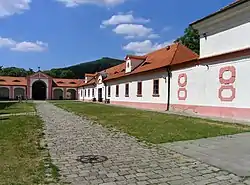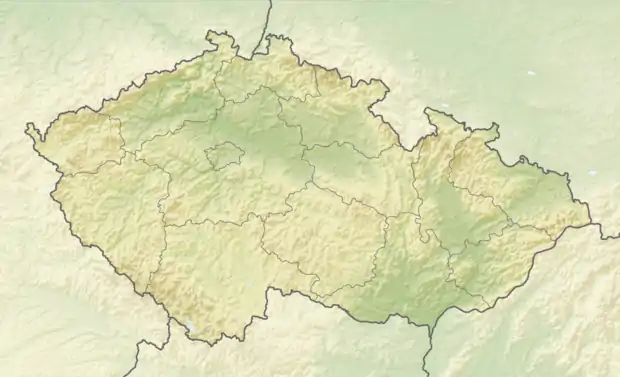Osek (Teplice District)
Osek (German: Ossegg) is a town in Teplice District in the Ústí nad Labem Region of the Czech Republic. It has about 4,700 inhabitants.
Osek | |
|---|---|
 Osek Monastery | |
 Flag  Coat of arms | |
 Osek Location in the Czech Republic | |
| Coordinates: 50°37′22″N 13°41′9″E | |
| Country | |
| Region | Ústí nad Labem |
| District | Teplice |
| Founded | 1196 |
| Government | |
| • Mayor | Jiří Macháček |
| Area | |
| • Total | 42.37 km2 (16.36 sq mi) |
| Elevation | 307 m (1,007 ft) |
| Population (2021-01-01)[1] | |
| • Total | 4,670 |
| • Density | 110/km2 (290/sq mi) |
| Time zone | UTC+1 (CET) |
| • Summer (DST) | UTC+2 (CEST) |
| Postal code | 417 05 |
| Website | www |
Administrative parts
Villages of Dlouhá Louka and Hrad Osek are administrative parts of Osek.
Geography
Osek is located approximately 8 kilometres (5 mi) east of Teplice and approximately 15 kilometres (9 mi) from the Czech-German border. The urban area lies at the foot of the Ore Mountains. Northern part of the municipal territory lies in the Ore Mountains.
Salesius Hill in Osek is a rock city of huge quartzite blocks, pillars and fissures. It is a nature monument.
History
Osek is notable for a Burgundian Gothic monastery, originally built as the three-nave "Church of the Assumption of Our Lady" between 1207 and 1220 in the style of a Roman Basilica, by Cistercian monks who first arrived in Osek in 1199.[2] The monastery complex grew over time to become the economic and social hub of the region. It was rebuilt, in the top baroque style by the architect Octavius Broggio, from 1712 till 1718 when the interior of the monastery church was decorated with fresco paintings by Václav V. Reiner and a new convent, library and chapels were constructed. When first installed, its church organ was one of the largest in Europe. The chapter hall of the old convent features a unique Early Gothic reading counter, carved from stone with an ornate base in the shape of a knot, dated in 1240.
Hussite Wars
The medieval castle Rýzmburk (Riesenburg) belonged to its founders, the noble Rýzmburk family until 1398; the ownership then shifted to the margraves of Meissen. It was one of the strongest fortresses in Bohemia and during the Hussite Wars was considered impenetrable. During the wars the monastery was twice burned down. Much of the monasteries property was also sold by emperor Sigismund to fund further military expeditions against the Hussites.
Economy
Osek is a known tourist destination in the region. The town has been undergoing intense maintenance and reconstruction to further increase tourism.
Culture
Osek Festival is an annual event with fairground markets, demonstrations of traditional crafts and funfair attractions.[3]
In popular culture
Parts of the film Anna Proletářka were filmed on location in Osek and Osek railway station.[4]
Notable people
- Karl Lieffen (1926–1999), German actor
- Kamil Střihavka (born 1965), singer
Gallery
 Klášterní square
Klášterní square Local shopping centre
Local shopping centre South part of Osek
South part of Osek Church in Osek Monastery
Church in Osek Monastery
References
- "Population of Municipalities – 1 January 2021". Czech Statistical Office. 30 April 2021.
- "Osek: The Cistercian monastery – Czech republic". Archived from the original on 6 February 2012. Retrieved 29 May 2007.
- "Osecká pouť" (in Czech). Kudy z nudy. Retrieved 15 July 2021.
- Anna proletárka (1953) – Filming locations
Literature
- Mario Feuerbach: Das Zisterzienserkloster Ossegg. Baugeschichte und Baugestalt von der Gründung 1196 bis in das Jahr 1691. Bernardus-Verlag, Heimbach 2009, ISBN 978-3-8107-9306-5.
- Mario Feuerbach: Das Kloster Osek, der Wallfahrtsort Mariánské Radčice und die Zisterzienser. Entwicklungswege im böhmisch-sächsischen Grenzgebiet, Orte der tschechisch-deutschen Begegnung / Klášter Osek, Poutní Místo Mariánské Radčice a Cisterciáci. Dialog, Litvínov 2012, ISBN 978-80-7382-151-7.
- Mario Feuerbach: Die Maßwerkfenster des gotischen Kreuzganges im Zisterzienserkloster Ossegg (Nordböhmen). In: Monumenta Misnensia. Jahrbuch für Dom und Albrechtsburg zu Meißen, Jg. 12 (2015), ISBN 978-3-9812406-4-1, p. 54–68.
- Mario Feuerbach: Das Zisterzienserkloster Ossegg (Osek) und sein Wallfahrtsort Maria Ratschitz (Mariánské Radčice) in der Zeit der Gegenreformation. Eine römisch-katholische Antwort auf Luthers Lehren. In: Marco Bogade (Hg.): Transregionalität in Kult und Kultur. Bayern, Böhmen und Schlesien zur Zeit der Gegenreformation. Böhlau, Köln/Weimar/Wien 2016, ISBN 978-3-412-50132-7, p. 263–272.
External links
| Wikimedia Commons has media related to: Osek (Teplice District) (category) |